In my last post, I tried to tackle getting the Top N Results per Group from a BigQuery dataset.
When I tweeted out the post, I got some great feedback and suggestions for more efficient ways to get the same results, so in this post I want to try to understand why the alternatives are more efficient.
First Attempt using ROW_NUMBER
Here’s the initial query I was using:
SELECT
subreddit,
author,
author_count,
total_score,
comment_rank
FROM (
SELECT
subreddit,
author,
SUM(score) AS total_score,
ROW_NUMBER() OVER (PARTITION BY subreddit ORDER BY SUM(score) DESC) AS comment_rank,
COUNT(DISTINCT author) OVER (PARTITION BY subreddit) AS author_count
FROM
`fh-bigquery.reddit_comments.2015_07`
WHERE
author NOT IN ('[deleted]',
'AutoModerator')
GROUP BY
1,
2 )
WHERE
comment_rank <= 10
AND author_count > 9
ORDER BY
1,
5
For the Top N problem, the key is computing the rank of each author’s scores, relative to the others in any particular group. In the query above, that’s this line:
ROW_NUMBER() OVER (PARTITION BY subreddit ORDER BY SUM(score) DESC) AS comment_rank,
The partition isolates the group, in this case a single subreddit. Then, you can order the authors by score within each group. The ROW_NUMBER function is a way to capture an ordered list of those partitioned ranks.
We use the ordered list position later in the main select as part of the WHERE clause to only take author’s whose subreddit-specific comment rank is in the top 10.
Here’s what the query plan looks like for our ROW_NUMBER query:
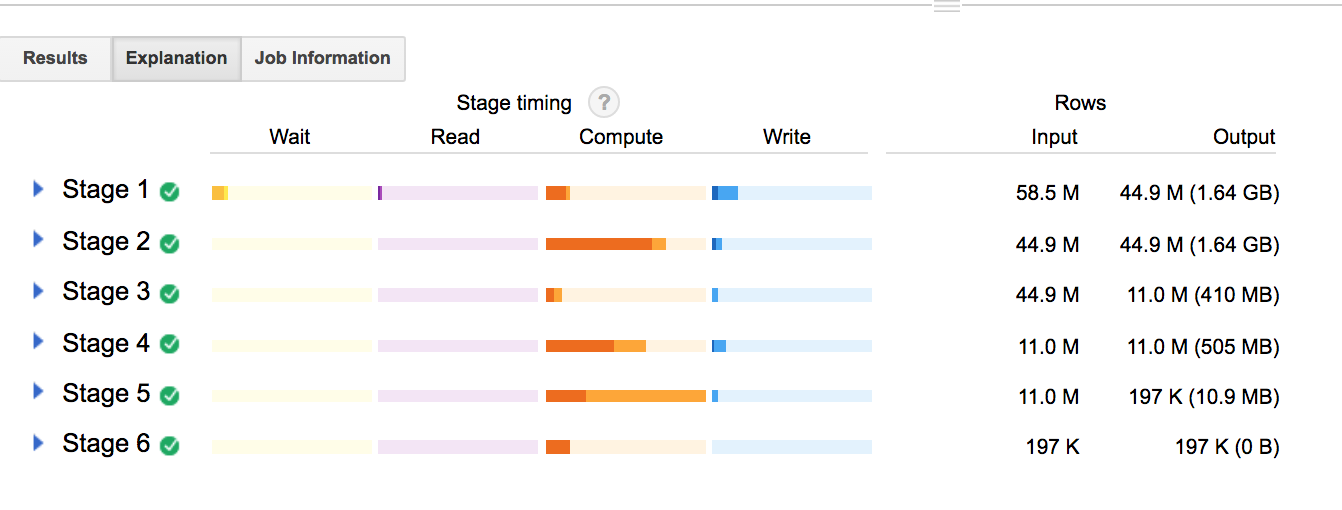
USING ARRAY_AGG
The next query that I wanted to try was suggested by Elliot Brossard who actually works on BigQuery at Google. And, if I had been paying better attention when I pulled my first pass solution from StackOverflow, I would have seen that he also made this suggestion on the original post. Thanks for your patience, Elliot!
Elliot suggests using ARRAY_AGG with a limit to get a set of ranked results instead of using the ROW_NUMBER function:
SELECT
subreddit,
ARRAY_AGG(STRUCT(author,
total_score)
ORDER BY
total_score DESC
LIMIT
10) AS top_authors
FROM (
SELECT
subreddit,
author,
SUM(score) AS total_score,
COUNT(DISTINCT author) OVER (PARTITION BY subreddit) AS author_count
FROM
`fh-bigquery.reddit_comments.2015_07`
WHERE
author NOT IN ('[deleted]',
'AutoModerator')
GROUP BY
1,
2 )
WHERE
author_count > 9
GROUP BY
subreddit
ORDER BY
1
ARRAY_AGG gives you a ton of power to condense parts of what we did in the first query.
- you can pull a subset of data into a single array, in this case
STRUCT(author, total_score), which gives you pretty much what we usedPARTITIONfor in the first query ARRAY_AGGtakesORDER BYandLIMITclauses, which together gives us the “top N” piece
Not only that, but the result set is reduced by an order of magnitude. The first query returns 196,970 results, or 10 rows per subreddit. But the ARRAY_AGG query only has 19,697 results because we only need one row per subreddit – the authors and there comment scores, per the STRUCT we defined in the SELECT statement are a single array value column.
Results using ROW_NUMBER
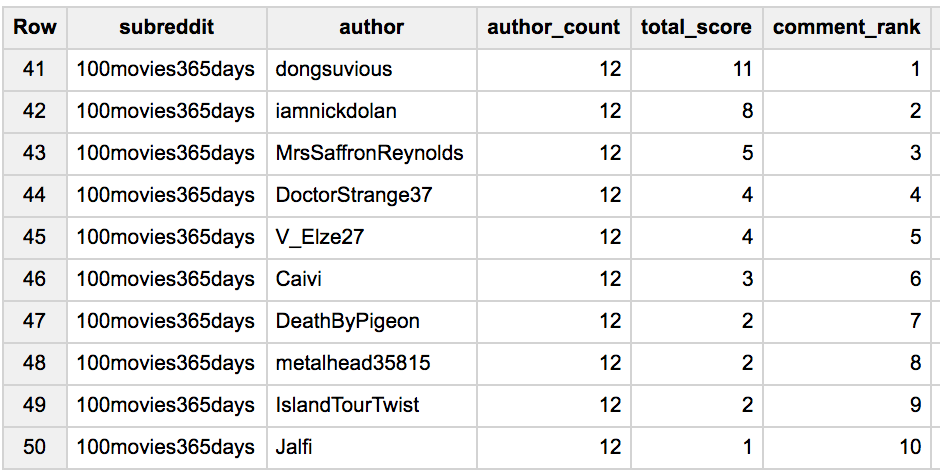
Results using ARRAY_AGG
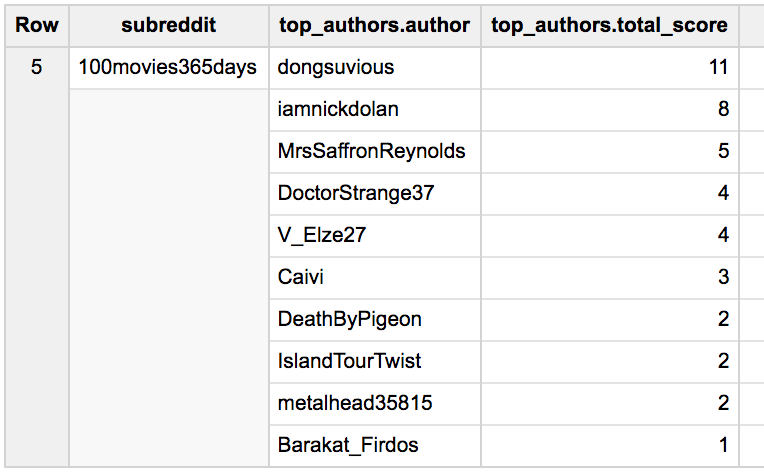
And check out the query plan for the ARRAY_AGG query:
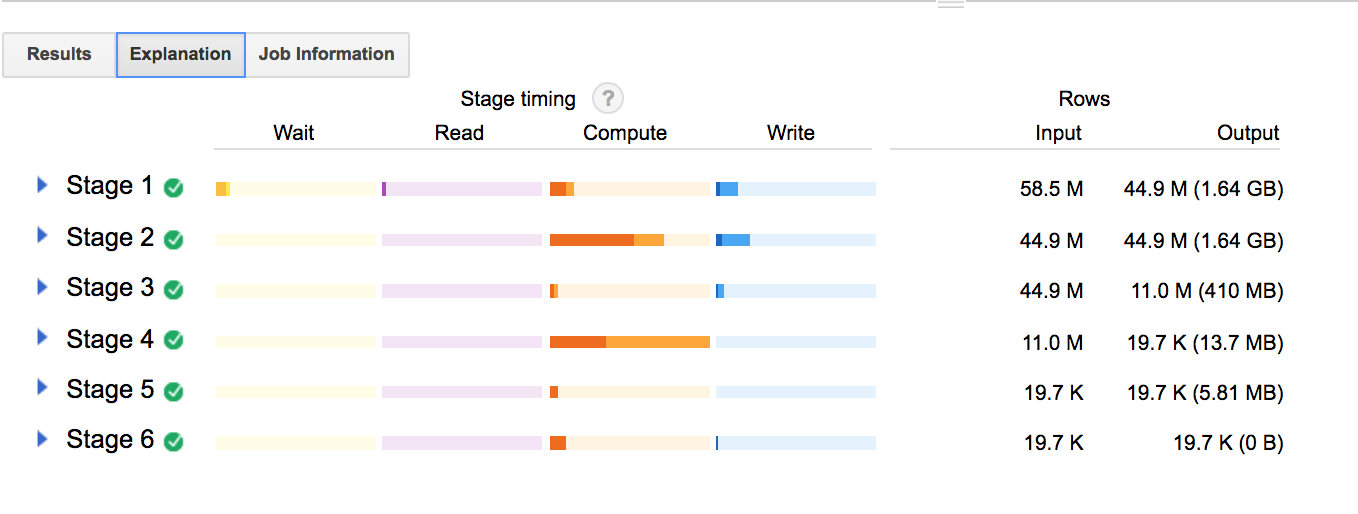
Now, the first 3 stages look pretty similar in terms of row input/output sizes and distribution of wait/read/compute/write. Both plans are working on the sub-select at this point, doing the sum of author comments, grouped by subreddit.
Stage 4 gets really interesting. The ARRAY_AGG query takes an row size input of 11.0 M and reduces the output to 19.7K.

In contrast, the ROW_NUMBER query does a bunch of compute on stage 4, but doesn’t reduce the output at all. It’s not until the FILTER in the next stage that we’ve cut down on the number of rows in the output (which we already know will still be 10x the ARRAY_AGG size).

It looks like using ROW_NUMBER forces us to:
- run over all the data again to generate our “ordered list” of comment rankings
- rank everything before we filter out subsets of results we don’t ultimately want
In contrast to the other query strategies, this is starting to seem like wasted compute effort.
USING APPROX_TOP_SUM
One more suggestion I got was to use the APPROX_TOP_ functions. In this case APPROX_TOP_SUM seemed to do the trick:
SELECT
subreddit,
APPROX_TOP_SUM(author,
total_score,
10) AS top_scores
FROM (
SELECT
subreddit,
author,
SUM(score) AS total_score,
COUNT(DISTINCT author) OVER (PARTITION BY subreddit) AS author_count
FROM
`fh-bigquery.reddit_comments.2015_07`
WHERE
author NOT IN ('[deleted]',
'AutoModerator')
GROUP BY
1,
2
HAVING
SUM(score) > 0 )
WHERE
author_count > 9
GROUP BY
1
ORDER BY
1
In the BigQuery documentation for this function it says that APPROX_TOP_SUM “returns the approximate top elements of expression, based on the sum of an assigned weight. The number parameter specifies the number of elements returned.
If the weight input is negative or NaN, this function returns an error.“
Emphasis added to point out that, of course, since we’re dealing with reddit comments, some of them have been downvoted to hell. Negative comment scores will actually break the APPROX_TOP_SUM function in this case.
There are over 200 subreddits in this dataset where the top-ranked commenters couldn’t break into positive comment counts. I had to add a HAVING clause to only grab total scores above 0.
You can see that filter getting applied in stage 3:

Compare that to the previous queries and you can see that stage 3 is where the total amount of data shrinks, thanks to those negative-ranked comments. But even with that caveat, it looks like
APPROX_TOP_SUM performs similarly to ARRAY_AGG. In fact, I went back to the ARRAY_AGG query and adding the same filter on SUM(score) just to be sure that the inputs and outputs would match at each stage for both queries. They do.
Still, there are a few differences to point out for APPROX_TOP_SUM:
- why there is an additional stage (highlighted in the screenshot below) that seems to just be shuffling or repartitioning based on some kind of metadata?
- how does the ‘approximate’ part of
APPROX_TOP_SUMfactor into the computation?
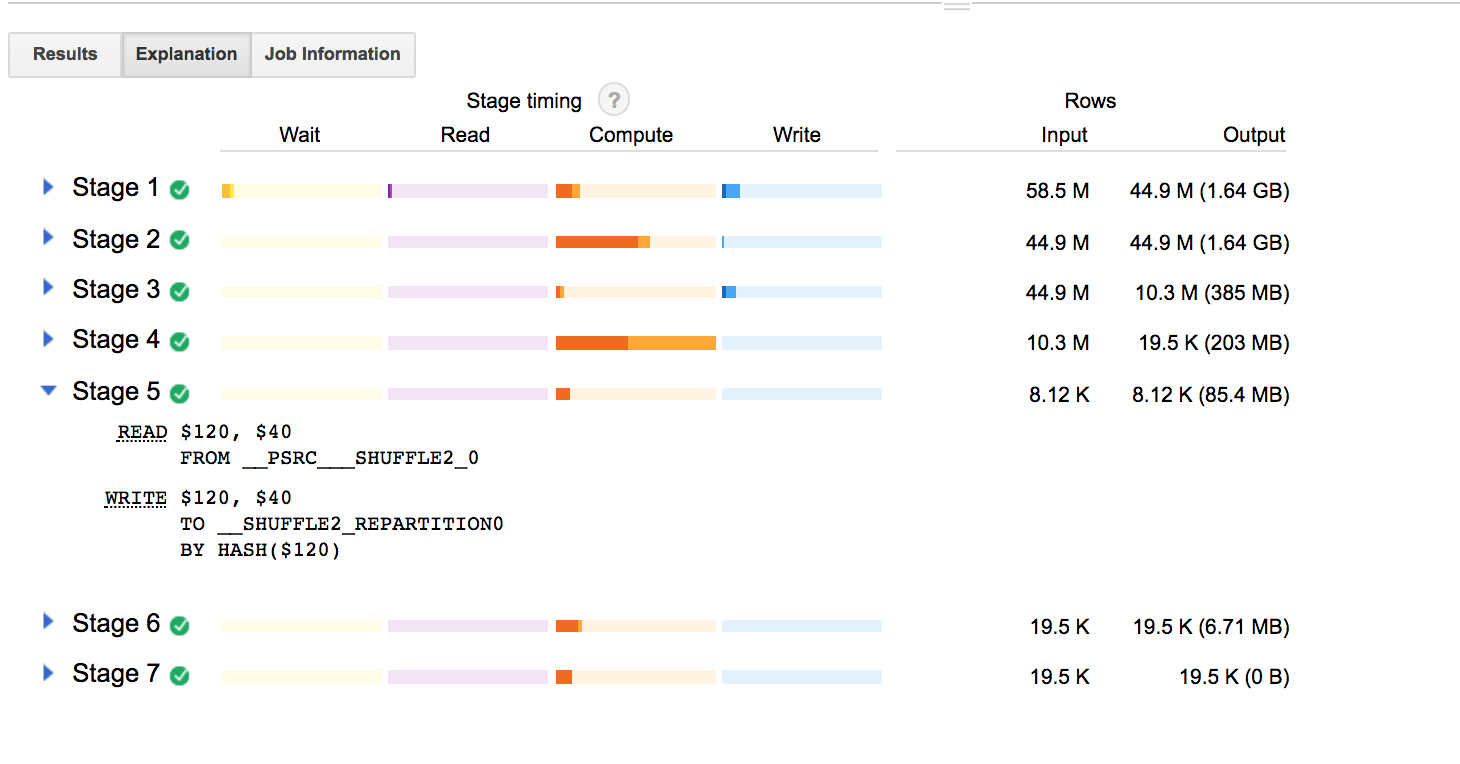
Other than that, it seems like both of these options deliver more concise results than the initial ROW_NUMBER solution. I’m looking forward to understanding the query explanation tools even better, so that in the future I can use them to diagnose my less efficient queries!

Share this post
Twitter
Google+
Facebook
Reddit
LinkedIn
StumbleUpon
Pinterest
Email